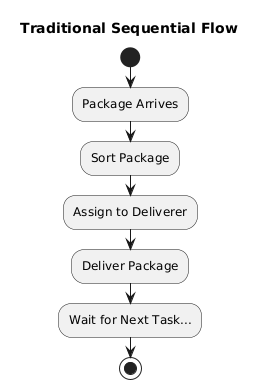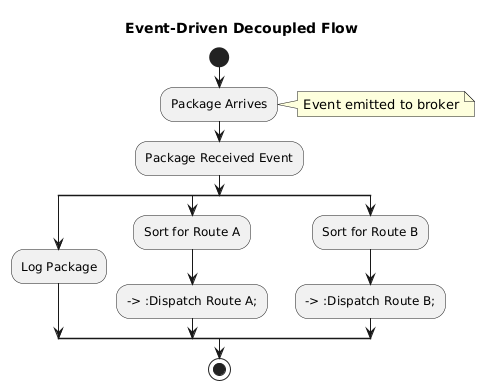Demystifying Event-Driven Architecture
By Puskar Dev • Published: 4/5/2025
Event-Driven Architecture (EDA) might sound complex, but at its core, it’s a surprisingly intuitive way to build software systems, especially ones that need to be responsive and scalable. Let’s break it down.
What is Event-Driven Architecture, Simply Put?
Imagine a busy post office. In a traditional system, you might have one person (a central process) trying to manage every single letter and package, telling everyone what to do step-by-step. If that person gets overwhelmed or makes a mistake, everything grinds to a halt.


In an event-driven system, things work more like a series of specialized mail sorters and delivery people who react to events.
- An “event” is simply something that happens. For example:
- A new package arrives at the post office (a “PackageReceived” event).
- A customer updates their shipping address (an “AddressUpdated” event).
- Payment for postage is confirmed (a “PaymentConfirmed” event).
- Different parts of your system (called “event consumers” or “subscribers”) are interested in specific types of events.
- When an event occurs, it’s announced (often through an “event broker” or “message queue” like Kafka, RabbitMQ, or AWS SQS/EventBridge).
- The interested parts of the system then pick up that event and do their specific job independently, without needing to know about all the other parts. For instance, when a “PackageReceived” event occurs:
- One system might log the package.
- Another might update inventory.
- A third might send a notification to the recipient.

So, instead of one component directly telling another component what to do (like a direct phone call), components in an EDA produce events and react to events. They are “decoupled.”
How is this Different from “Traditional” Systems?
Traditional architectures, often called request-response or monolithic systems, typically work like this:
- Direct Communication: Component A needs something from Component B, so it makes a direct request (e.g., a function call or an HTTP API call).
- Waiting: Component A often has to wait for Component B to finish and send a response before it can continue.
- Tight Coupling: If Component B is down or slow, Component A is directly affected. Changes in Component B might require changes in Component A.
- Synchronous Flow: Operations usually happen in a specific, predefined sequence.
Think of it like ordering food at a restaurant where the waiter takes your order, goes to the kitchen, waits for the food, and then brings it back to you. The waiter is tied up with your order until it’s complete.
Key Benefits of Event-Driven Architecture
So, why go through the trouble of setting up this event-based flow? The benefits are significant, especially for complex and growing applications:
- Improved Scalability:
- Different parts of your system can be scaled independently. If you get a flood of “OrderPlaced” events, you can scale up just the order processing services, not the entire application.
- The event broker can handle massive volumes of events, acting as a buffer.

-
Enhanced Resilience and Fault Tolerance:
- If one service (an event consumer) fails, other services can often continue to operate. For example, if the notification service is down, orders can still be processed and inventory updated. The notification service can catch up on events when it comes back online.
- This “decoupling” means failures are isolated.
-
Increased Agility and Flexibility:
- You can add new services that react to existing events without modifying the services that produce those events. This makes it easier to evolve your system and add new features.
- Different teams can work on different microservices independently.
-
Real-time Responsiveness:
- Systems can react to events as they happen, leading to more immediate updates and a better user experience. For example, a dashboard can update in real-time as new sales events come in.
-
Better Data Flow and Auditability:
- Events can be logged and replayed, which is great for debugging, auditing, and even for rebuilding the state of a system.
- You get a clear history of what happened in your system.
-
Loose Coupling:
- Services don’t need to know about each other directly. They only need to know about the events they produce or consume. This reduces dependencies and makes the system easier to maintain and change.
When to Consider EDA?
Event-Driven Architecture isn’t a silver bullet for every problem, but it shines in scenarios like:
- Microservices: It’s a natural fit for coordinating actions between many small, independent services.
- Real-time Data Processing: Applications that need to react instantly to streams of data (e.g., IoT sensor data, financial tickers, social media feeds).
- Asynchronous Workflows: Tasks that can be done in the background without the user waiting (e.g., sending emails, generating reports, processing images).
- Systems Requiring High Scalability and Resilience: When uptime and the ability to handle load spikes are critical.
- Integrating Disparate Systems: Events can act as a common language for different applications to communicate.
While there’s a learning curve and some added complexity in managing event brokers and ensuring event consistency, the long-term benefits in scalability, resilience, and flexibility often make Event-Driven Architecture a powerful choice for modern software.